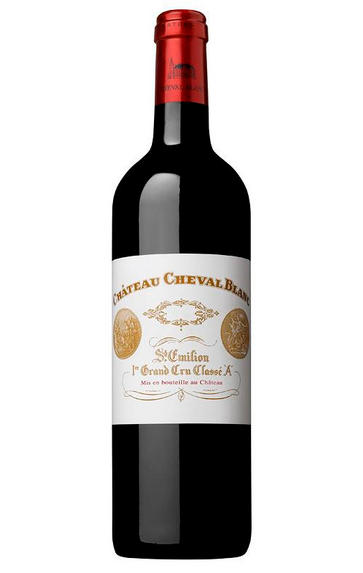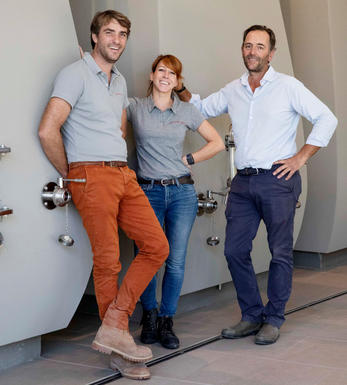
2010 Château Cheval Blanc, St Emilion, Bordeaux

Critics reviews
Robert M. Parker, Jr. - 28/02/2013
Jancis Robinson MW- jancis robinson.com April 2011
James Molesworth - Wine Spectator - 30 Mar 2011
100 Robert Parker- Wine Advocate- Feb 2013
The 2010 Cheval Blanc contains 13.8% alcohol, which is very high for this estate, and has an unusually high percentage of Cabernet Franc in the final blend (56% versus 44% Merlot). Yields were tiny, adding to the richness and intensity already instilled by the drought of summer and resulting tiny berries. In the style of some of the great Cheval Blancs of the late 1940s, this wine is rich, opulent, full-bodied, and at the risk of sounding like a broken record, as saturated purple in color as any Cheval Blanc I have seen. Mulberries, black currants, fresh minerals, and floral notes jump from the glass of this full-bodied, dense wine. With its tannins, good acidity and surprisingly modest pH, this should be an exceptionally long-lived wine, more backward and delineated than the fatter, more opulent 2009. Drink it over the next 30+ years.
96-98+ Robert Parker- Wine Advocate- May 2011
Tim Atkin MW, www.timatkin.com, May 2011
About this WINE

Château Cheval Blanc
Château Cheval Blanc, a 1er Grand Cru Classé (A) is unquestionably the leading estate in St. Emilion. It is located in the north-west of the St. Emilion appellation, bordering Pomerol.
Cheval Blanc's vineyards (Merlot 39%, Cabernet Franc 57%, Malbec 3%, Cabernet Sauvignon 1%) enjoy a variety of soils: gravel, clay and sand, all underpinned by an impermeable sedimentary rock (`crasse de fer'). Fermentation and maceration last 4 weeks in stainless steel vats, followed by 18 months' maturation in new oak barrels.
Cheval Blanc produces the most famous Cabernet Franc-based wine in the world and present régisseur Pierre Lurton is amongst the most talented winemakers working in Bordeaux today. Cheval Blanc requires a minimum 10 years of bottle age and the best vintages can last for 50 years or more.

St Émilion
St Émilion is one of Bordeaux's largest producing appellations, producing more wine than Listrac, Moulis, St Estèphe, Pauillac, St Julien and Margaux put together. St Emilion has been producing wine for longer than the Médoc but its lack of accessibility to Bordeaux's port and market-restricted exports to mainland Europe meant the region initially did not enjoy the commercial success that funded the great châteaux of the Left Bank.
St Émilion itself is the prettiest of Bordeaux's wine towns, perched on top of the steep limestone slopes upon which many of the region's finest vineyards are situated. However, more than half of the appellation's vineyards lie on the plain between the town and the Dordogne River on sandy, alluvial soils with a sprinkling of gravel.
Further diversity is added by a small, complex gravel bed to the north-east of the region on the border with Pomerol. Atypically for St Émilion, this allows Cabernet Franc and, to a lesser extent, Cabernet Sauvignon to prosper and defines the personality of the great wines such as Ch. Cheval Blanc.
In the early 1990s there was an explosion of experimentation and evolution, leading to the rise of the garagistes, producers of deeply-concentrated wines made in very small quantities and offered at high prices. The appellation is also surrounded by four satellite appellations, Montagne, Lussac, Puisseguin and St. Georges, which enjoy a family similarity but not the complexity of the best wines.
St Émilion was first officially classified in 1954, and is the most meritocratic classification system in Bordeaux, as it is regularly amended. The most recent revision of the classification was in 2012

Merlot/Cabernet Franc
Merlot and Cabernet Franc are grape varieties commonly used in Bordeaux-style blends, particularly in the Bordeaux region of France. When these two grapes are blended, they can create a wine that combines the best characteristics of each variety.
Merlot is known for its smoothness, soft tannins, and ripe fruit flavours. It often contributes black cherry, plum, and chocolate flavours to the blend. The grapes are relatively easy to grow and ripen earlier than other Bordeaux varieties, making them versatile for blending.
Cabernet Franc, on the other hand, adds structure, depth, and complexity to the blend. It typically brings aromas of red fruits such as raspberry and strawberry, along with herbal notes like bell pepper and tobacco. These grapes have thinner skins and can be more challenging to cultivate, requiring specific growing conditions to reach their full potential.
When Merlot and Cabernet Franc are combined, the result is a well-balanced wine with various flavours and aromas. The blend often exhibits a Bordeaux wine's medium to full body, along with a smooth texture and moderate tannins. The specific flavour profile can vary depending on the proportions of each grape in the blend and the terroir and winemaking techniques employed.


Buying options
Add to wishlist
Description
After seemingly years in the doldrums Cheval is back in the game! Producing a wine this year that is worthy of its Premier Grand Cru Classé and legendary status. There is a heavenly nose of warm, ripe, crunchy red summer berries and a multi-layered and exotic (but not at all pushed or forced) mouthfeel.
There is a great grip with fine chewy tannins and an exceptional finish that goes on until you get to St Emilion (about 5 mins away!) A true legend in the making, to rival its brilliant 1998 or 1982.
(56% Cabernet Franc, 44% Merlot. 14.5% abv)
Simon Staples, BBR Fine Wine Director
wine at a glance
Delivery and quality guarantee